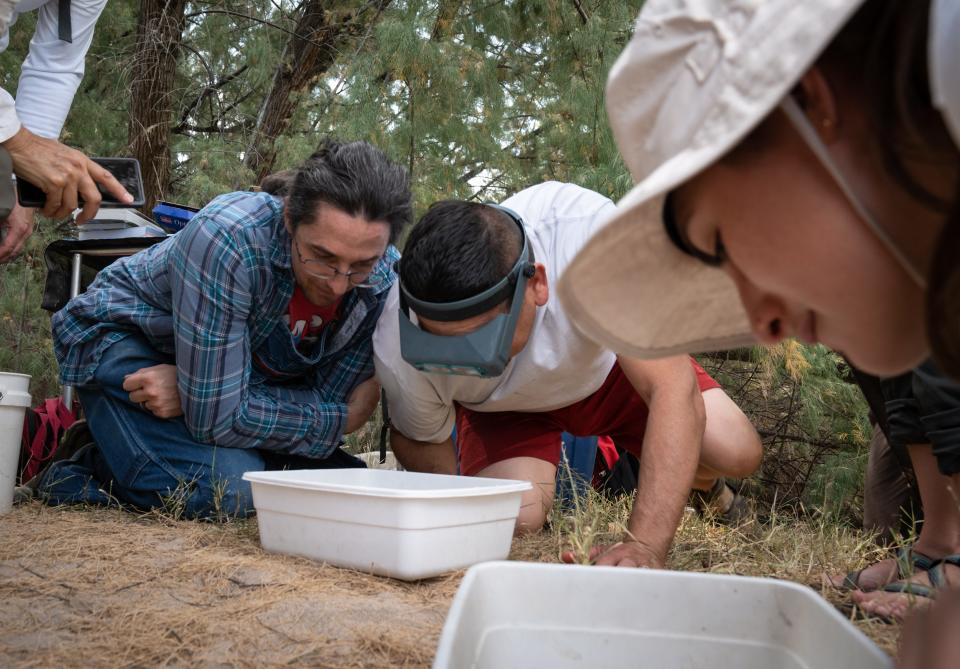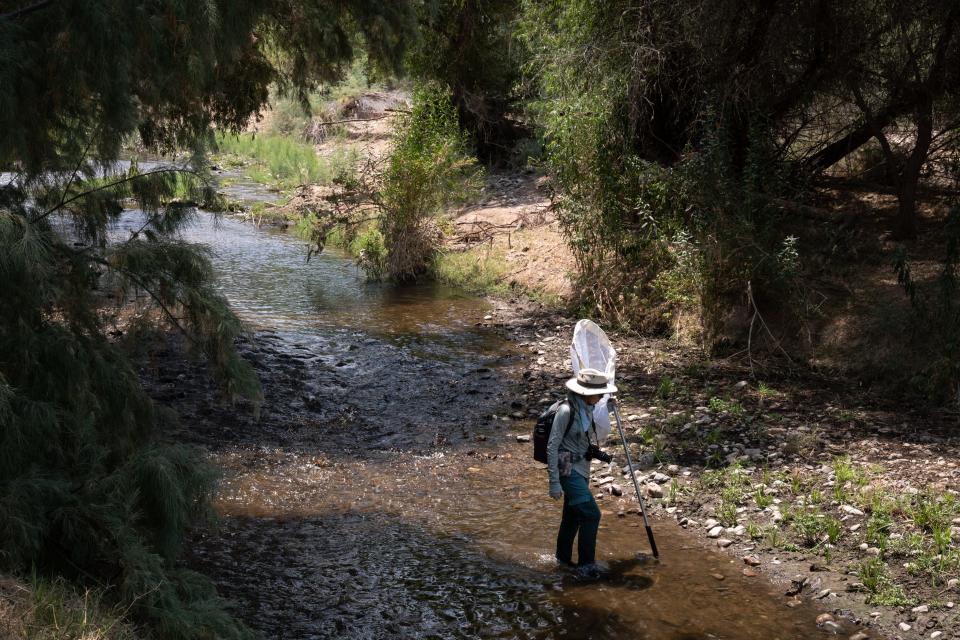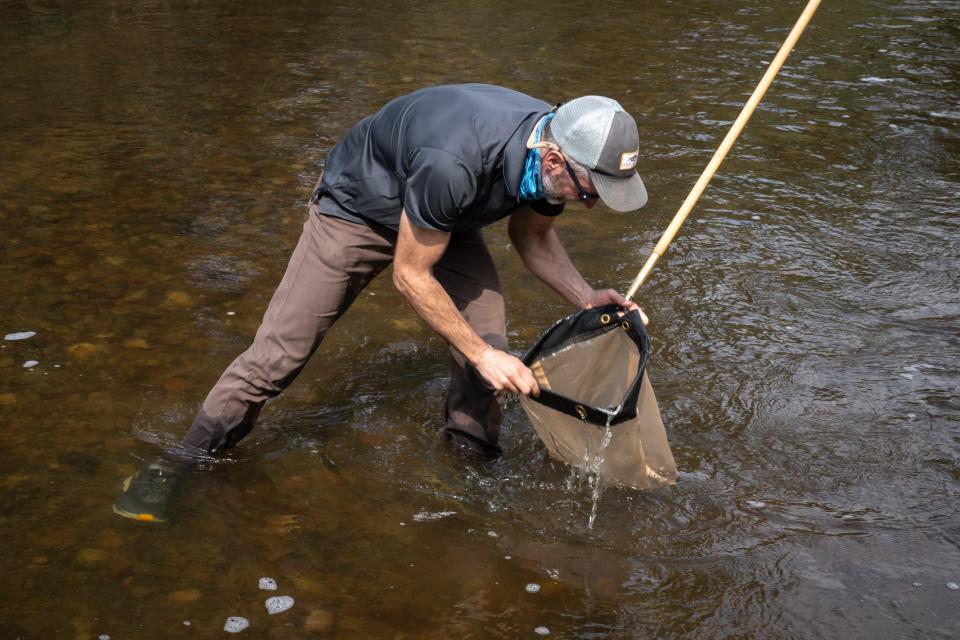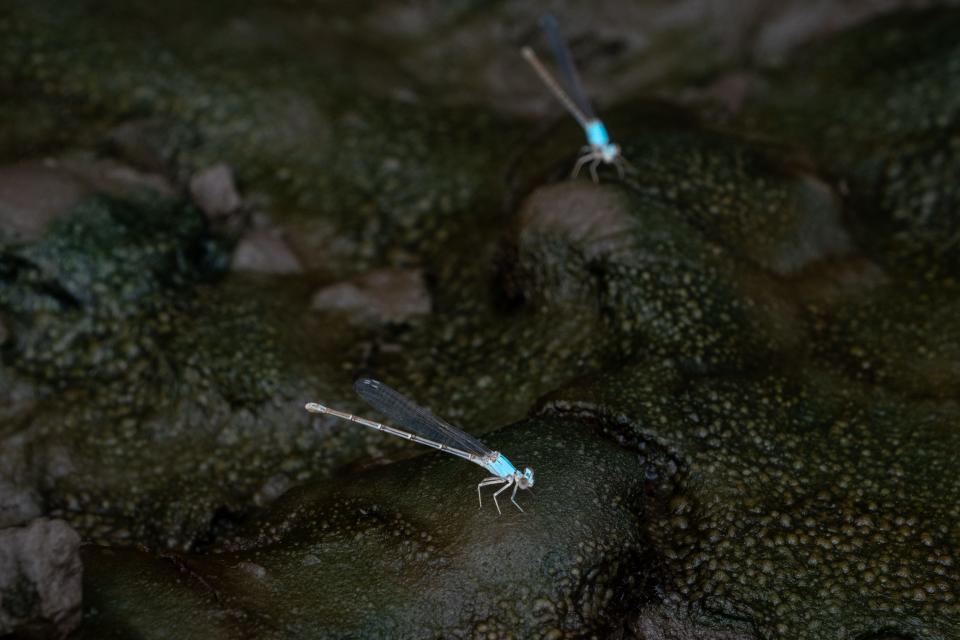'I can picture my students here': Arizona teachers become learners at hands-on science program
MARANA — They peered into buckets of water, all of them down on all fours under the shade of a tall salt-cedar tree amid the loud song of cicadas. Inside the buckets, tiny creatures swarmed.
"Wow!" "Gnarly!" "Cool!" "They are eating each other!", they shouted.
They're school teachers, ranging in age from 25 to 58, but on this day, they were the learners, part of an immersive summer research experience identifying the early life stages of damselfly and dragonfly species that now populate a 15-mile section of flowing stream in the Santa Cruz River. The site is one of three stretches that flourished with life after public entities began releasing high-quality treated wastewater into the desert wash.
Researchers are monitoring the transformation of this renewed habitat, and teachers from metro Tucson and the Tohono O’odham and Pascua Yaqui nations are tagging along to learn from current research, create place-based lessons and bring new hands-on science teaching to the classroom.
"It’s given me a lot of ideas of how to introduce students to issues outside the textbook. To do science instead of only learning about it,” Marco Cubillas, a sixth-grade teacher of ecology and chemistry at Roskruge Bilingual Magnet Middle School, said in Spanish.
That morning, near Marana, the group picked up rocks at the bottom of the river looking for insect larvae, swung nets to catch adult damselflies and learned how researchers measure population trends.
“I can picture my students here," Cubillas said cheerfully as they waded knee-deep in the stream. "They’d love it, they’d learn so much. We learn in many different ways, especially by doing.”
The cohort was the second of three that will take part in a six-week University of Arizona summer program called Research Experiences for Teachers Sites in Biological Science, or BIORETS. The program, funded by the National Science Foundation, supports and finances biological research experiences for K-12 teachers, often pairing them with scientists to work on a site or project.
It is an opportunity to engage K-12 teachers with current research, but also with larger issues in the community.
For Michael Bogan, associate professor at the UA and lead of the BIORETS program on the Santa Cruz River, the benefits go beyond the educational component.
The program can extend awareness about the existence and value of the Santa Cruz River, Bogan said, even when the flow depends on clean effluent discharges.
“For generations, when the river was dry, people just lost connection with it," Bogan said. "They no longer thought of it even as a river.”
“If all we accomplish is all of those students knowing about the river and why it's important and then they went home and told their parents about it," Bogan continued, "to me, that's a big success."
Bridging the gap in science teaching

In the program, teachers hear from public entities and nonprofits doing water conservation and recharge. They participate in training to collect and analyze data, brainstorm on simple research approaches, and try new teaching tools and software. They also follow researchers into the field, do plant surveys, set up camera traps and tour important sites.
A big component of the program indoors is the work on data literacy, said Rebecca Lipson, co-principal investigator on the BIORETS program. Teachers learn what data is needed to answer research questions, what certain data can and cannot show, practice how to read it and create visualizations.
“Any career in STEM these days is heavy on data, so it really is an integral part, if (students) want to pursue education and careers in the field," said Lipson, who leads pedagogy discussions and training in the summer program along with education specialist Margaret Wilch.
Modernizing the understanding of current research is also a priority.
“There is really a gap between what students learn in K-12 and the type of learning and research that is happening at the university," said Lipson, who has taught middle-school science and now supports undergraduate research initiatives.
"If they only know what they read in books and those books are dated, and they don't have an understanding of what research looks like, they might not be inspired to pursue STEM careers," she said, adding that the Santa Cruz River program is designed to connect to the community and inspire the students to get involved.
The engagement component, where students take part in the process of science, is now a requirement under recent changes to the Arizona Science Standards. Lipson believes the program can help teachers adapt.
“The curriculum moved from learning a lot of information to now investigating phenomena and having students be the scientist, asking the questions, doing the investigations, coming to conclusions through their own activities," she said.
"It's exciting but the part that is difficult for many people is that there isn't a guidebook on how to do that."
Taking the classroom outdoors
Rachel Carpenter had plenty of experience as an educator but less as a science instructor. Attempting to do real science and data collection with her students felt like a stretch, she said.
The program offered her a door to research and experts and “jumpstarted something,” she said.
After the pandemic, she “really wanted to bring things to life” and used her time at BIORETS to network and partner with the Pima County Natural Resources education department and Audubon for her students’ projects. They built and installed bird boxes at the school and nearby parks and monitored them for Lucy’s warblers.

Carpenter took new training at Arizona State University’s Southwest Urban Corridor Integrated Field Laboratory and with the Central Arizona Project.
"I feel more connected to a lot of the environmental, climate issues and energy issues that are happening now around us,” she said. “I feel more confident in understanding them, reaching out to people and asking questions, and bringing those back to my students."
The program also checked an important priority for her: It anchored learning on “things that are happening right here, right now around them," she said.
Jessica Pitts, a teacher at Valencia Middle School and part of the first cohort, returned to the river with 72 sixth-graders with help from Michael Bogan. For many, the trip was their first visit to an Arizona stream they didn't know existed.
Depending on their background, the class they teach and the resources available, teachers have a variety of ideas on how to integrate what they learned into the classroom.
Jennie Quijada, a recent graduate of conservation biology and teacher at Rincon High School, had the science background but was looking for more tools to bring field research into the classroom.
She remembers hating “textbook-based” science in high school. It was in college, at one particular camping trip watching raptors around the Vermilion Cliffs, where she was hooked.
"This is what school could be," she tells students, encouraging them to pursue STEM careers.
She plans to take students on several small field trips at the UA campus, replicating plant surveys they practiced at the summer program, and make two visits a year to sites like the river.
Anna Verdiguel Gillet, who teaches biochemistry at Flowing Wells High School, plans to blend what they learned at the program with human health-focused classes, using knowledge on wastewater treatment and ecology, and pulling in studies that correlate stream health to human health.
The two BIORETS cohorts so far brought in teachers from six school districts: the Arizona State School for the Deaf and Blind, Flowing Wells, Tucson Unified School District, Altar Valley Elementary District, Baboquivari Unified School District, and two Bureau Indian Education schools: Tohono O'odham High School and Santa Rosa Day School.

Jacqueline Bruhn, general coordinator of the program, said the six-week experience builds “community-wide awareness.”
“Hundreds of Tucson area students will have a teacher who spent their summer collecting data with their toes in the flowing waters of the Santa Cruz River,” she said.
Life in the river is reborn
Once perennial, the Santa Cruz River only flows in about five stretches year-round, all of them with treated effluent or “imported” water.
The first is between Rio Rico and Tubac and receives about 13 million gallons a day from the Nogales International Wastewater Treatment Facility. The second is on the San Xavier reservation, where years of restoration with Colorado River water have even brought groundwater levels up to the surface. The third is the Santa Cruz River Heritage Project near downtown Tucson, where the Tucson Airport Remediation Project water treatment facility sends about 345,000 gallons a day to the wash around West Starr Pass Boulevard.
Online learning to stay: 3 years since COVID-19 closed schools, some AZ families choose online learning for the long haul
The fourth section is near Sweetwater Wetlands Park and currently receives an average of 4.6 million gallons per day. The fifth section starts around Ina Road and flows north up to 20 miles to Trico Road with about 30 million gallons per day from the Tres Rios Water Reclamation Facility.
Near Marana, effluent discharges started around the 1970s, but poor treatment made the water too rich and low in oxygen for many species to establish. It was in 2013, with high-quality treated effluent, that life took off.
Willows, cattails, small fish and Sonoran mud turtles have returned to sections of the river that now flow year-round.
That early morning on the river near Marana, Bogan and Rocío Guzmán, a doctoral student specializing in dragonflies and damselflies of the Sonoran Desert, taught teachers about the insects’ life cycle, their connection to stream health and how to conduct surveys.
The Santa Cruz was “wiped clean” from aquatic life when the communities nearby dried it up, Bogan said. Species have to come back from other areas.
Before it received high-quality treated effluent, the river section in Marana had about five dragonfly species. It now has about 50.
"Since 2013, all 48 of those other species had to fly from somewhere else," Bogan said. Some came from Tanque Verde, Sabino Canyon, Cienega Creek and the Santa Cruz River in Tubac.
New species have also appeared. Bogan and Guzmán recorded the presence of a neotropical bluete in the river stretch near Marana. The dragonfly was found before only in Mexico and a very short section of the Gila River.
The diversity and type of species also offers information about the recovery of the Santa Cruz River.
Dragonflies, and many other living creatures, are better indicators of the health of a body of water than expensive water quality equipment, Bogan said.
Where the water flows: A shot of recycled water revives a flourishing ecosystem on the Santa Cruz River in Tucson
Water sensors take a snapshot of the conditions but can miss critical information, like a plant discharging toxic waste the next morning. Bugs are there all the time, and their lifetime is telling of whether a site is livable at all, he explained.
There are hardy species that can survive with raw sewage, though seeing them in abundance is not necessarily good. Other species are highly sensitive to water pH, nutrient concentration, oxygen levels in the water and amount of water flow. Seeing a diversity of species in abundance is a good indicator for the river.
Threats to the flow of treated water
Water has revived sections of the river, but there are no guarantees all treatment plants will keep discharging water in years to come. Water is in high demand, and treatment plants could send the treated effluent to other users.
Water entities earn credits for sending the treated water to the river, as it helps recharge the aquifer. Those credits help them offset groundwater pumping later.

The stretch of river near the Agua Nueva plant and the Heritage Project gained some “water rights” in 2021. Tucson and Pima County approved a plan to create a “conservation effluent pool” for both sites, which dedicates water to the river to keep the ecosystem going. The stretch near Agua Nueva will get 5 million gallons per day. For the Heritage Project, the daily commitment is variable but will not exceed more than 35.8 million gallons a year, which comes to around 10,000 gallons a day.
There is no water commitment for the longest stretch of stream receiving water from the Tres Rios plant. The site, which receives the largest volume of water of all three in the metro area, is also on state trust land, which means it could be sold and developed at any point.
Close to midday, the group emerged from the wash and walked up a dirt trail above the tamarisk and willow trees. Out in the open, the scorching heat scattered teachers to their cars. Nearby, a bulldozer worked a big mountain of gravel, dug from the deposits that the waters of the Santa Cruz River once moved.
Clara Migoya covers environmental issues for The Arizona Republic and azcentral. Send tips or questions to clara.migoya@arizonarepublic.com.
Environmental coverage on azcentral.com and in The Arizona Republic is supported by a grant from the Nina Mason Pulliam Charitable Trust. Follow The Republic environmental reporting team at environment.azcentral.com and @azcenvironment on Facebook, Twitter and Instagram.
This article originally appeared on Arizona Republic: Teachers study science on the Santa Cruz River, teach it later

